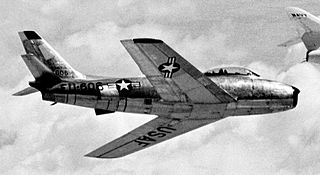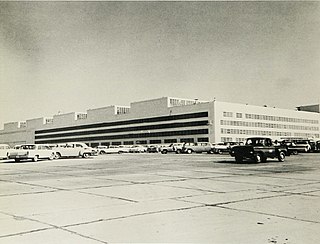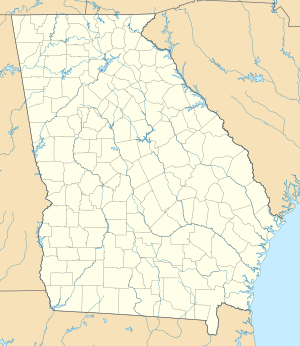
The Lockheed Corporation was an American aerospace manufacturer. Lockheed was founded in 1926 and merged in 1995 with Martin Marietta to form Lockheed Martin. Its founder, Allan Lockheed, had earlier founded the similarly named but otherwise-unrelated Loughead Aircraft Manufacturing Company, which was operational from 1912 to 1920.

The Boeing B-29 Superfortress is an American four-engined propeller-driven heavy bomber, designed by Boeing and flown primarily by the United States during World War II and the Korean War. Named in allusion to its predecessor, the B-17 Flying Fortress, the Superfortress was designed for high-altitude strategic bombing, but also excelled in low-altitude night incendiary bombing, and in dropping naval mines to blockade Japan. B-29s dropped the atomic bombs on Hiroshima and Nagasaki, the only aircraft ever to drop nuclear weapons in combat.

The Glenn L. Martin Company, also known as The Martin Company from 1917 to 1961, was an American aircraft and aerospace manufacturing company founded by aviation pioneer Glenn L. Martin, which operated from 1917 to 1961. The Martin Company produced many important aircraft for the defense of the US and allies, especially during World War II and the Cold War. During the 1950s and '60s, the Martin Company moved from the aircraft industry into the guided missile, space exploration, and space utilization industries.

The Bell Aircraft Corporation was an American aircraft manufacturer, a builder of several types of fighter aircraft for World War II but most famous for the Bell X-1, the first supersonic aircraft, and for the development and production of many important civilian and military helicopters. Bell also developed the Reaction Control System for the Mercury Spacecraft, North American X-15, and Bell Rocket Belt. The company was purchased in 1960 by Textron, and lives on as Bell Textron.

Dobbins Air Reserve Base or Dobbins ARB is a United States Air Force reserve air base located in Marietta, Georgia, a suburb about 20 miles (32 km) northwest of Atlanta. Originally known as Dobbins Air Force Base, it was named in honor of Captain Charles M. Dobbins, a World War II C-47 pilot who died near Sicily.

The XX Bomber Command was a United States Army Air Forces bomber formation. Its last assignment was with Twentieth Air Force, based on Okinawa. It was inactivated on 16 July 1945.

Royal Air Force Station Wormingford is a former Royal Air Force station located 6 miles (9.7 km) northwest of Colchester, Essex, England.

The 58th Air Division is an inactive United States Air Force unit. Its last assignment was with Air Defense Command, based at Wright Patterson Air Force Base, Ohio. It was inactivated on 1 February 1959.

The Battle of Kansas was the nickname given to a project to build, modify, and deliver large quantities of the world's most advanced bomber to the front-lines, originally in Europe and also in the Pacific, although because of delays in production, it was used only in the Pacific. The battle began as the first B-29 Superfortresses rolled off the production lines of the massive new Boeing factory on the prairies near Wichita, Kansas.

The 357th Airlift Squadron is a Tactical Airlift unit of the United States Air Force assigned to the Air Force Reserve Command and part of the 908th Airlift Wing at Maxwell Air Force Base, Alabama. It operates Lockheed C-130H Hercules aircraft providing global airlift. The 357th AS operates (8) C-130H2 aircraft that were built in the 1990s, which utilize Flight Engineers and Navigators, along with the crew complement of Pilots and Loadmasters.

The 700th Airlift Squadron is part of the 94th Airlift Wing at Dobbins Air Reserve Base, Georgia. It operates Lockheed C-130 Hercules aircraft providing global airlift.

The 731st Airlift Squadron is a flying unit of the United States Air Force assigned to the Air Force Reserve Command and part of the 302d Airlift Wing at Peterson Air Force Base, Colorado. It operates Lockheed C-130H Hercules aircraft providing global airlift. The squadron also has the specialized mission of Modular Airborne Fire Fighting System.

The 20th Bomb Squadron is a unit of the 2d Operations Group of the United States Air Force located at Barksdale Air Force Base, Louisiana. The 20th is equipped with the Boeing B-52H Stratofortress.

The 812th Fighter-Bomber Squadron is an inactive United States Air Force unit. Its last assignment was with 482d Fighter-Bomber Group stationed at Dobbins Air Force Base, Georgia.

Boeing Plant 2 was a factory building which was built in 1936 by The Boeing Company in King County, Washington in the United States. By the time production ceased in the building, the plant had built half of the Boeing B-17 Flying Fortresses, the Boeing 307 Stratoliners, the Boeing 377s, some of the Boeing B-29 Superfortresses, Boeing B-50 Superfortresses, B-47 Stratojets, B-52 Stratofortresses, and the initial Boeing 737s. It was located between the Duwamish River and Boeing Field, to the east of the 16th Avenue South bridge, facing East Marginal Way South.

Air Force Plant 4 is a government-owned, contractor-operated aerospace facility in Fort Worth, Texas, currently owned by the U.S. Air Force and operated by Lockheed Martin Aeronautics. It is home to the F-16 and F-35 fighter aircraft. Military aircraft have been manufactured at the plant since 1942. Plant 4 is adjacent to Naval Air Station Joint Reserve Base Fort Worth, formerly Carswell Air Force Base.

United States Air Force Plant 42 is a classified aircraft manufacturing plant owned by the United States Air Force in the Antelope Valley, about 60 miles from downtown Los Angeles. It is also used by the National Aeronautics and Space Administration (NASA).

Air Force Plants NC was an aircraft production facility established during World War II adjacent to Fairfax Field near Kansas City. Although operated by North American Aviation, the plant was built and owned by the United States government.

The Glenn L. Martin Bomber Plant was an aircraft manufacturing facility in the central United States, located at Offutt Field, Nebraska, south of Omaha. Adjacent to suburban Bellevue in Sarpy County, the plant was operational during World War II, from 1942 to 1945.

James Vinson Carmichael was member of the Georgia General Assembly, an attorney, business executive, and candidate for Governor of Georgia.






















